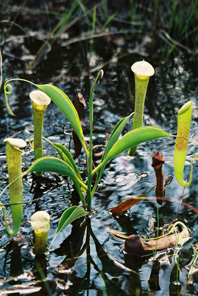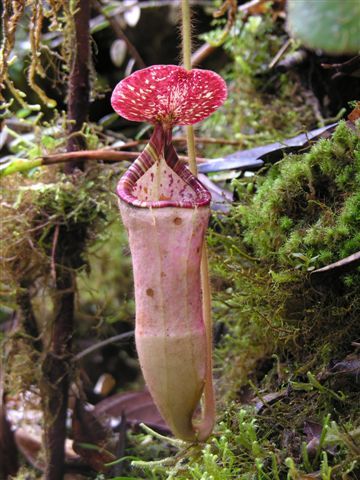Rat-Eating Plant Discovered
Posted by: Loren Coleman on January 22nd, 2008

Nepenthes tenax
Here is another one for your cryptobotany file!
It is not a cow-eating tree from India – (as per here, here, and here) – , but a rat-eating pitcher plant from Australia.
A rare new species of plant that eats small rats has been discovered at the tip of Cape York.
Pitcher plants, otherwise known as flesh-eating plants, grow throughout Cape York but now a new, larger species that grows like a vine has been discovered.
The new species has been called “Tenax”.
James Cook University ecologist Charles Clarke and a colleague found the new species at a swamp near the Jardine River, but exactly where is a secret.
“They are quite vulnerable,” he said.
“They are only found in a few small areas and if we broadcast the location then there are people out there who would take advantage of that.
“There’s a lot of interest in pitcher plants from Australia, even from people outside of Australia.
“And while people often associate these things with New Guinea or Borneo or Sumatra, the fact that there’s more species here is actually very exciting.”“Rat-eating plant discovered in Cape York,” Australian Broadcasting Corporation, January 22, 2008.
Nepenthes tenax (Latin: tenax = tenacious) is a lowland species of tropical pitcher plant native to northern Queensland, Australia. It is the third Nepenthes species recorded from the continent, and its second endemic species. N. tenax is closely related to the two other Australian Nepenthes species: N. mirabilis and N. rowanae.
N. tenax grows to a height of around 100 cm with pitchers rarely exceeding 15 cm. The stem is usually self-supporting. In its natural habitat, it is sympatric with N. mirabilis and N. rowanae. Two natural hybrids involving these species have been found.
Reference:
Clarke, C.M & R. Kruger 2006. “Nepenthes tenax C.Clarke and R.Kruger (Nepenthaceae), a new species from Cape York Peninsula, Queensland.” Austrobaileya 7(2): 319–324.

Not a tenax but certainly an example of how beautiful pitcher plants can be.
About Loren Coleman
Loren Coleman is one of the world’s leading cryptozoologists, some say “the” leading living cryptozoologist. Certainly, he is acknowledged as the current living American researcher and writer who has most popularized cryptozoology in the late 20th and early 21st centuries.
Starting his fieldwork and investigations in 1960, after traveling and trekking extensively in pursuit of cryptozoological mysteries, Coleman began writing to share his experiences in 1969. An honorary member of Ivan T. Sanderson’s Society for the Investigation of the Unexplained in the 1970s, Coleman has been bestowed with similar honorary memberships of the North Idaho College Cryptozoology Club in 1983, and in subsequent years, that of the British Columbia Scientific Cryptozoology Club, CryptoSafari International, and other international organizations. He was also a Life Member and Benefactor of the International Society of Cryptozoology (now-defunct).
Loren Coleman’s daily blog, as a member of the Cryptomundo Team, served as an ongoing avenue of communication for the ever-growing body of cryptozoo news from 2005 through 2013. He returned as an infrequent contributor beginning Halloween week of 2015.
Coleman is the founder in 2003, and current director of the International Cryptozoology Museum in Portland, Maine.










There are rats in Australia? Marsupial rats?
“There are rats in Australia? Marsupial rats? ”
There are (placental) rats native to Australia, iirc.
Rats are so intelligent and they are such mobile, capable creatures – I wonder how the plant manages to prevent the rat from escaping?
kittenz asks:
“I wonder how the plant manages to prevent the rat from escaping?”
You’re kidding, right? It’s obvious: the pitcher plants have little televisions inside, and most of them get cable.
😉
Actually, the real answer is: Most pitcher plants, especially after periods of rain, have a watery mix in the “pitcher” that contains a nectar attractor plus more. The nectar is spiked with a narcotic element, so that the animal visitor soon feel less than stable, loses it balance or footing and plunges into a vat of watery digestive juices where it drowns.
LOL I thought they might have a little Wii set up … a wee Wii, pardon the pun 😉 .
A friend just sent me a link for a Wii promotion that mentions Bigfoot. I sent it along in an email to Cryptomundo, of course !
Great picture. It worries me that these plants are in a vulnerable spot. This is such a great discovery. I am already fascinated with carnivorous plants and raise many of them at home including sundews and picture plants and of course venus fly traps. I hope to hear of new carnivorous plant discoveries in the future. They are truly remarkable.
So the plants get the rat stoned huh? No wonder humanity has yet to come up with the perfect rat trap! 🙂
I think this is an incredible find. Think how startling this would be if other pitcher plants were not already known. I really hope this plant is successfully protected.
Are there any fossil records of giant carnivorous plants?
Reminds me of a lawnmower eating dandelion I once did battle with. I mowed the lawn one evening and the next day a dandelion was blooming in the yard and the mower was gone. Neighbors thought the mower was stolen but I still suspect the dandelion. 🙂
Seems the rats in Australia should be kangaroo rats. 🙂
Hi plantgirl – everything biological in Australia is in a vulnerable spot at the moment 🙁
Camperguy – they did quite well protecting the dinosaur-aged Wollemi Pine (found incidentally within 100km of the country’s most populous city – Sydney, at about 4 million heads) – and not only that, but profiting from commercialising it. It wouldn’t surprise me if they do a good job with this one too.
Ahhh I love cryptobotany. I think it’s interesting to point out that the reports of “man-eating trees” in Madagascar tell of the tree as having a sweet, some may say “narcotic” nectar. After a person drinks this nectar they fall victim to a seemingly horrible death . The plant in this article may eat rats, but it’s diet more than likely consists of a host of smaller organisms. (insects, lizards, small birds, etc.) The term “rat-eating” means that the plant is capable of eating rats, not dependent on rats.
I saw some lovely plantings of various species of pitcher plants last fall at Kanapaha Gardens in Gainesville, FL. Some of the plants were quite large. I knew that they sometimes trap animals the size of mice and frogs, but it blows my mind that an animal the size of a rat can be trapped. It just never occurred to me.
If they can grow to a size that can trap a rat, I don’t see any reason they couldn’t grow even larger. Maybe there are plants out there that can trap animals like squirrels or even monkeys. There are potentially millions of plant species yet to be discovered.
I’m a cryptobotany enthusiast, too. I especially love to hear of discoveries such as the Wollemi Pine. Those trees are awesome! They have a wonderful “prehistoric” appearance. It’s great that they are preserving the integrity of the Wollemi’s habitat while at the same time making seedlings available around the world. Not only will that “spread the eggs around to more than one basket”, but much of the income from royalties on the sales is returned to Wollemi Pine International to provide funds for continuing conservation. There’s some very good information about them at http://www.wollemipine.com.
Thank you Loren, for the cryptobotany post, one of my favorite subjects. 🙂
Would this be 15 cm in pitcher length, or diameter?
From Wikipedia,
Either would be sufficient to swallow a rat; placental, or marsupial.
From the picture, I assume it would be an aquatic rat.
Any info on the species?
Nothing like a little ratatouille.
well if science cant prove bigfoot and sea serpents exist well theres nothing like a good plant story.
Here is a little reality check on rats in Australia:
There is an update on this issue posted on January 28th.